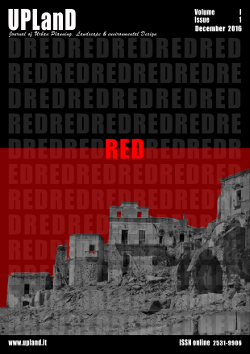Drosscapes Recycle: a strategy for risk management through landscape
Main Article Content
Abstract
The debate on divestment and drosscapes is taking a much more central role in the post industrialization period within the modern societies.
It is a fact the perspective of a constant and linear growth has been lost.
The economic development stopped and turned itself in a “degrowth” which was questionably theorizing as a new "happy" phase.
However the decline and the large consequent divestments bring out a new pattern of availability both in territories and designers.
The traditional deficiency of urban spaces to allocate complex functional cities equipments is nowadays replaced by a virtual excess of empty urban spaces which are theoretically "ready" to play other roles.
In this process, the private capital could play an important role in the transformation of citizen in consumer, if the institutions fail in being an efficient "guarantors" with respect of the urban role these areas have to maintain.Downloads
Article Details

This work is licensed under a Creative Commons Attribution-NonCommercial-NoDerivatives 4.0 International License.
Authors who publish with this journal agree to the following terms:- Authors retain copyright and grant the journal right of first publication with the work simultaneously licensed under a Creative Commons Attribution License that allows others to share the work with an acknowledgement of the work's authorship and initial publication in this journal.
- Authors are able to enter into separate, additional contractual arrangements for the non-exclusive distribution of the journal's published version of the work (e.g., post it to an institutional repository or publish it in a book), with an acknowledgement of its initial publication in this journal.
- Authors are permitted and encouraged to post their work online (e.g., in institutional repositories or on their website) prior to and during the submission process, as it can lead to productive exchanges, as well as earlier and greater citation of published work (See The Effect of Open Access).
References
Berger, A. (2007). Drosscape.Wasting land in urban America. Princenton, NJ: Architectural Press
Berger, A. (2011). Exterial Landscape. Topos, 76.
Calcagno Maniglio, A. (ed.) (2010). Progetti di paesaggio per i luoghi rifiutati. Roma,IT: Gangemi Editore.
De Poli, M.D., Incerti, G. (2011). Atlante dei paesaggi riciclati. Milano,IT: Skira.
Lynch, K . (1990).Wasting away. Sierra Club Books. trad. it.: 1992, Michael Southwork (ed.), Napoli, IT: Deperire, Cuen.
Marini, S. (2011).The landscape of waste, Milano, IT: Skira.
Ricci, M. (2012). Nuovi Paradigmi. Milano, IT: La Feltrinelli.
Ricci, M. (a cura di).( 2003). Rischiopaesaggio. Milano, IT:Meltemi Editore.
Russo, M. (1988). Aree dismesse. Napoli, IT: Edizioni Scientifiche Italiane.
Secchi, B. (1985). Il territorio abbandonato I, Casabella, 512.
Secchi, B.(1985). Il territorio abbandonato II. Casabella, 513.
Trasi, N. (2004). Paesaggi rifiutati Paesaggi riciclati. Prospettive e approcci contemporanei. Le aree estrattive dismesse nel paesaggio: fenomenologia di un problema progettuale. Roma,IT: Editrice Librerie Dedalo.
Viale, G. (1994). Un mondo usa e getta. La civiltà dei rifiuti e i rifiuti della civiltà. Milano,IT: Feltrinelli
Zanfi, F. (2008). Città latenti. Un progetto per l’italia abusive. Milano,IT: Bruno Mondadori.

